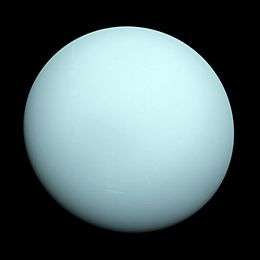Herschel Orbital Reconnaissance of the Uranian System
 | |
| Operator | NASA |
|---|---|
| Major contractors | Applied Physics Laboratory |
| Mission type | Imaging and reconnaissance by orbiter |
| Launch date | April 2021 (proposed) |
| Mission duration | ≥2 years |
| Satellite of | Uranus |
| Orbital insertion date | 2038 |
| Power | Nuclear |
Herschel Orbital Reconnaissance of the Uranian System (shortened as HORUS) is a proposed mission to Uranus. If launched in 2021, it would arrive in approximately 2038, and would spend at least 2 years imaging 100% of the surfaces of Uranus's moons and studying Uranus's atmosphere, magnetosphere, etc. The concept was proposed by the Applied Physics Laboratory in 2010.[1] The power supply would be nuclear.
Instruments
The majority of the instruments would be "borrowed" and modified from current planetary exploration missions, including Juno, New Horizons, BepiColombo, Cassini–Huygens, and MESSENGER.
- Long Range Reconnaissance Imager (LORRI) - Borrowed from New Horizons, designed for high-resolution imaging in visible wavelengths.
- Linear Etalon Imaging Spectral Array (LEISA) - Borrowed from the Ralph telescope on board New Horizons, LEISA is a near-infrared imaging spectrometer.
- Energetic Particle Spectrometer (EPS) - Borrowed from MESSENGER, EPS is designed to measure the charged particles in Uranus's magnetosphere,
- Fast Imaging Plasma Spectromer (FIPS) - Also borrowed from MESSENGER, FIPS is designed to measure the charged particles coming from Uranus's cloud tops.
- Cosmic Dust Analyzer (CDA) - Borrowed from Cassini-Huygens. The CDA is a direct sensing instrument that measures the size, speed, and direction of tiny dust grains near Uranus. Some of these particles are orbiting Uranus, while others may come from other star systems. The CDA on the orbiter is designed to learn more about these particles, the materials in other celestial bodies and potentially about the origins of the universe.
- Flux Magnetometer - Borrowed from Juno, designed to measure the strength and direction of the magnetic field lines.
See also
References
- ↑ Smith, R.W. et. al. (2010). "HORUS - Herschel Orbit Reconnaissance of the Uranian System" (PDF). Lunar and Planetary Institute. Retrieved August 26, 2015.
External links
This article is issued from Wikipedia - version of the 11/8/2016. The text is available under the Creative Commons Attribution/Share Alike but additional terms may apply for the media files.
